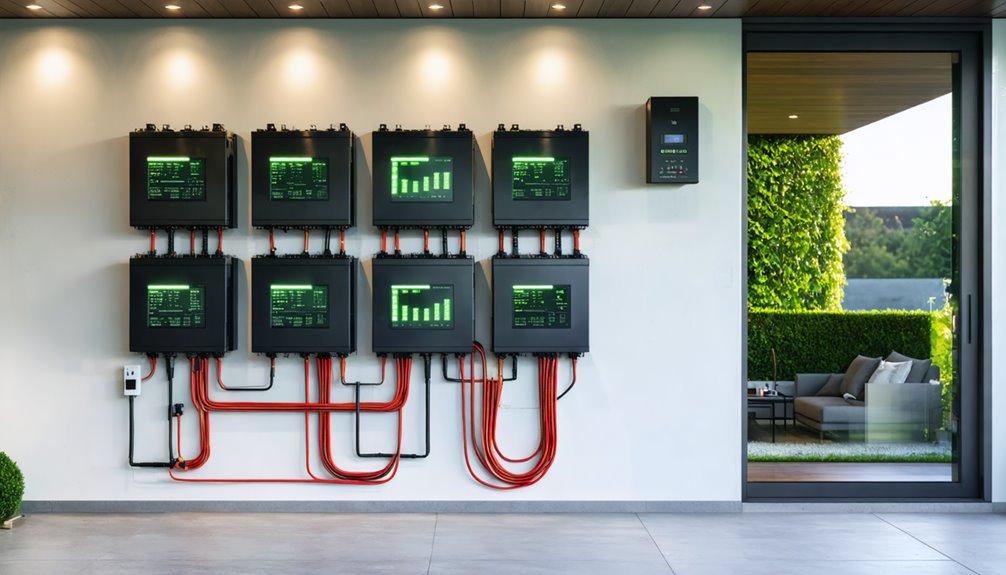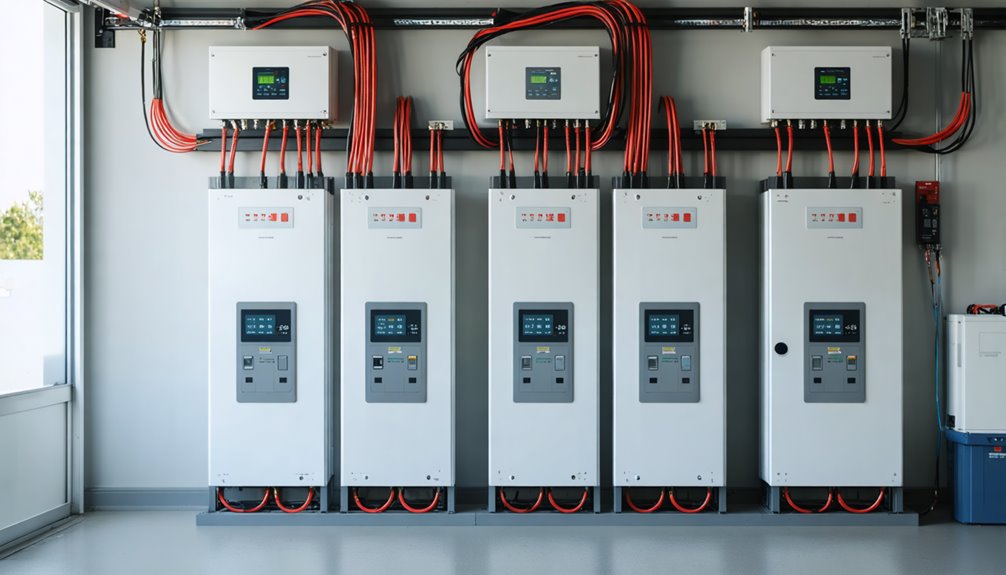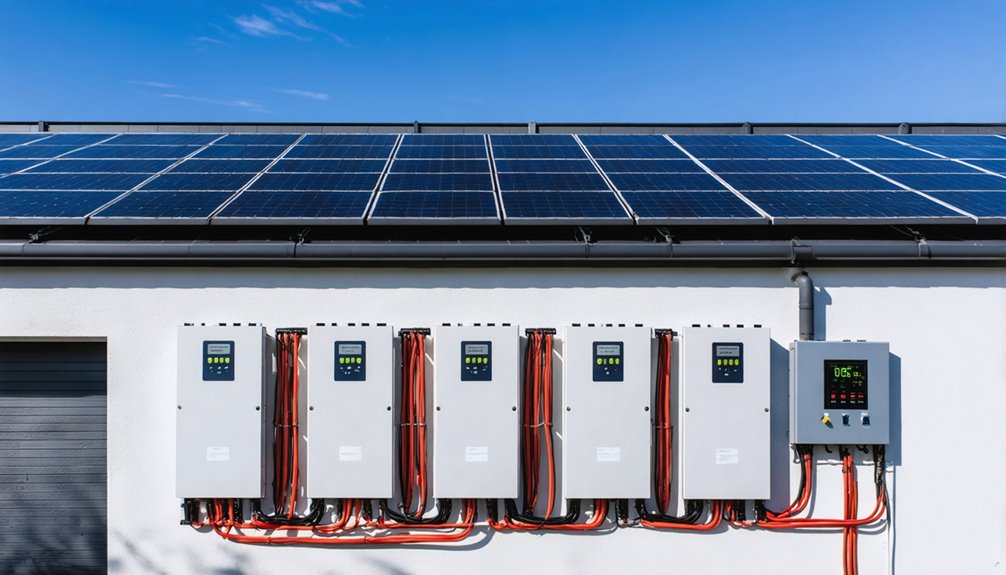You’re looking at your electric bill and wondering if solar batteries could cut your costs. The average American home uses about 30 kilowatt-hours daily, but here’s what’s surprising: you might not need as many batteries as you’d think. Some homeowners get by with just one or two, while others install a dozen. The difference comes down to three critical factors that determine your exact needs.
Understanding Your Energy Goals for Solar Battery Storage
Your home’s energy appetite drives how many solar batteries you’ll need. Before choosing solar battery storage, you’ll want to identify your specific energy goals.
If you’re looking to save money, you’ll typically need just 1-2 batteries. These store extra solar energy from your solar energy system during the day. You can use this stored power when electricity costs more.
For backup power during outages, the number of batteries changes. One 13 kWh battery keeps essential systems running for about three days. Larger homes might need 2-3 batteries for complete backup coverage.
Those seeking total grid independence need the most storage capacity. They’ll often require 8-12 batteries. Your daily energy consumption and which appliances you’ll run during outages determine the exact count. Additionally, understanding the potential long-term savings from solar batteries could influence your decision on the number of batteries needed.
Calculating Your Daily Energy Consumption
Most homeowners need to know exactly how much energy they use before sizing their solar battery system. You’ll find your daily energy consumption on past utility bills, measured in kilowatt-hour (kWh) units. The average U.S. home uses about 30 kWh per day.
Your energy-consuming appliances determine your total daily usage. You’ll calculate this by listing each device’s wattage. The formula is: (Wattage × Hours used) ÷ 1000 = kWh.
Seasonal variations affect your numbers greatly. You’ll use more power for heating in winter or cooling in summer. Smart energy monitoring devices track your real-time usage. They’ll show which appliances consume the most power. These tools help you understand your home’s exact energy patterns throughout the year.
When preparing for a solar battery system, it’s important to understand that solar panel ratings and efficiency factors play a crucial role in how effectively your system can meet your energy needs throughout various seasons.
Assessing Your Solar Panel System’s Production Capacity
To figure out how many batteries you’ll need, you must first understand how much electricity your solar panels actually produce each day. Your system’s daily output depends on its total wattage and the number of peak sunlight hours your area receives. Most residential solar systems generate between 4 to 12 kWh daily, but factors like shading and weather can greatly affect these numbers. It’s important to consider using high-efficiency panels like those from JinkoSolar and Trina Solar to maximize energy output and optimize your solar system’s performance.
Daily Solar Output Estimation
When calculating how much electricity your solar panels produce each day, you’ll multiply your system’s total capacity by the average peak sunlight hours in your area. Most locations get between 4 to 6 peak sunlight hours daily. If you’ve got a 5 kW solar panel capacity and receive 5 hours of peak sunlight, you’ll generate about 25 kWh of energy produced each day.
Your daily solar output changes with seasonal variations. Summer’s longer days boost solar production, while winter’s shorter days reduce it. Your panels’ efficiency matters too they’re typically 15-20% efficient, which affects actual capacity. Several factors influence your system’s performance, including shadows from nearby objects, your roof’s direction, and its angle. These elements determine how much electricity you’ll actually generate throughout the year.
Peak Production Hours
Between 10 a.m. and 3 p.m., your solar panels work hardest, producing the most electricity during these peak production hours. That’s when sunlight hits strongest, and your solar panel system generates the most power.
During these hours, you’ll see your panels creating excess energy beyond your household energy requirements. Your system’s capacity determines how much electricity you’ll make. Most systems produce about 1,000 to 1,500 kilowatt-hours yearly per installed kilowatt.
Your location affects production too. Sunnier areas generate more power than cloudy regions. Shade from trees or buildings also reduces output.
Understanding your average daily solar generation during peak hours helps determine your battery storage needs. Energy storage systems must capture this extra power for nighttime use. This information’s essential for figuring out how many batteries you’ll need.
Determining Storage Needs for Cost Savings Through Load Shifting
As electricity prices spike during peak hours, you’ll need to figure out how much battery storage can help you save money through load shifting. Most households use about 30 kWh of daily energy consumption. You’ll typically need one to two batteries with 10-15 kWh battery capacity each for effective load shifting.
Your energy storage system should match your peak electricity usage patterns. Many homeowners find that storing half their daily usage works well. This strategy can cut utility bills by 30-50%.
Consumption-only batteries cost about two-thirds less than backup systems. They’re designed specifically for load shifting without emergency power features. Smart technology lets you track and manage your energy use in real-time, making your system even more efficient for cost savings. Additionally, understanding battery chemistry differences can help you choose the most compatible battery for your solar setup, enhancing both cost-effectiveness and performance.
Battery Requirements for Essential System Backup

Most homeowners need at least one 10 kWh battery to keep essential appliances running during power outages. A single lithium-ion battery with this storage capacity can power critical appliances for about three days in most U.S. areas.
If you want backup for larger systems like heating and cooling, you’ll need more batteries. Three or more lithium-ion batteries with around 30 kWh total capacity can handle these bigger loads. Since the average home uses about 30 kWh of daily energy usage, matching your battery capacity to this number guarantees reliable backup.
Standard solar setups shut off during outages without batteries. The depth of discharge matters too it determines how much stored power you can actually use while keeping your batteries healthy for years. Proper maintenance practices can also extend the lifespan of your solar batteries, ensuring you get the most out of your investment.
Planning for Whole-Home Backup Power
When you’re planning for whole-home backup power, you’ll need to think bigger than just keeping the lights on. Your energy needs jump greatly when powering an entire house. The average home uses about 30 kWh daily, which means you’ll typically need three or more lithium-ion batteries for complete coverage.
Your home solar battery system’s storage capacity depends on your energy consumption patterns. Most households require 30 kWh of storage to achieve whole-home backup during outages. If you’re going off-grid, experts say you’ll need 8 to 12 batteries. This accounts for days without sunlight while maintaining your solar power system’s reliability. Businesses can also benefit from solar batteries to reduce dependency on fossil fuels, which enhances sustainability and operational efficiency.
Solar professionals can help determine the exact number of batteries you’ll need based on your specific usage and backup goals.
Choosing the Right Battery Size and Capacity
You’ll need to understand battery capacity basics before selecting the right solar battery for your home. Most residential lithium-ion batteries range from 3 to 18 kWh, and you’ll typically need one to three units to power essential appliances during outages. Your specific energy consumption patterns and backup power needs will determine whether you’ll require a smaller system or a larger battery bank like those used in off-grid homes. It’s also important to consider the benefits of energy independence that battery storage can provide, as it allows you to store and use solar power even when your panels aren’t producing electricity.
Battery Capacity Basics
Battery capacity determines how much power you can store and use from your solar system. Most lithium-ion batteries for homes hold between 10 and 20 kWh. That’s kilowatt-hours – the unit that measures battery capacity.
Your daily energy consumption affects your storage needs. The average U.S. home uses about 30 kWh per day. A single 10 kWh battery won’t cover that completely.
Usable capacity matters too. You can’t always use 100% of what’s stored. A 10 kWh battery might provide enough power for essential systems during a three-day outage.
Your energy goals shape how many batteries you’ll need. For basic cost savings, one or two batteries work. For full-home backup or living off-grid, you’d need eight to twelve batteries.
Sizing Your System
Figuring out the right battery size starts with looking at your home’s power needs. The average U.S. household uses about 30 kWh of electricity daily. When sizing your system, you’ll typically need battery capacity to store half that amount – around 15 kWh for peak times.
Your energy consumption patterns determine how many solar batteries you need. For backup power during outages, one 10-13 kWh battery can run essential systems for three days. Grid-connected homes often need just 1-3 batteries ranging from 10-20 kWh for solar power storage.
Off-grid setups require more – usually 8-12 batteries to meet peak demands. You’ll also need to take into account your area’s daily solar production to guarantee batteries recharge properly on sunny days.
Matching Energy Goals
The right battery setup depends on what you’re trying to achieve with your solar system. You’ll need different battery capacity levels for different energy goals. If you’re looking to save money during peak hours, one or two solar batteries can handle your power consumption needs. Most household uses during these times won’t require massive storage.
For backup power during outages, a single 13 kWh battery typically keeps essential systems running for three days. But if you want complete energy independence, you’ll need eight to twelve batteries. That’s because your storage must cover periods when solar production drops.
Your daily energy use matters too. The average home needs about 30 kWh per day. Without enough battery capacity, you’ll rely on the grid or net energy metering programs.
Configuring Multiple Batteries for Your Storage Needs

When you’re setting up solar batteries for your home, you’ll need to calculate your total storage needs based on how much energy you use daily. Most homeowners cut their daily usage in half to figure out backup power needs. Common lithium-ion batteries range from 3 to 18 kWh in storage capacity. Larger homes often need three or more batteries to power essential systems. Each battery model has different usable capacity, so you’ll want to check these numbers carefully. For off-grid solar systems, experts recommend installing 1.8 to 2 times your daily energy consumption in total battery capacity. This extra storage helps during cloudy days when solar panels produce less power. Some homeowners mix AC-coupled and DC-coupled systems to meet their total storage requirement. Keep in mind that additional costs like inverters, monitoring systems, and permits can add $2,000-$5,000 to the total investment.
Grid-Connected vs. Off-Grid Battery Requirements
Your battery needs will change dramatically depending on whether you’re connected to the power grid or living completely off it. Grid-connected homes typically need just 1-3 batteries with 10-20 kWh of storage for backup power during outages. Off-grid homes require much larger setups with 8-12 batteries since they can’t rely on the utility company when solar production drops.
Grid-Connected Battery Needs
How many batteries do you actually need if you’re connected to the power grid? Most households need 1 to 3 backup batteries with 10 kWh or more storage capacity. Your energy usage determines the exact number.
A single 10 kWh battery powers essential systems for about 3 days. But if you want whole-house backup with air conditioning, you’ll need around 30 kWh – that’s three or more batteries.
| Battery Setup | Storage Capacity | Coverage |
|---|---|---|
| Basic | 10 kWh | Essential systems only |
| Standard | 20 kWh | Most appliances |
| Complete | 30+ kWh | Whole house with AC |
Grid electricity access means you don’t need as much storage as off-grid homes. Smart solar battery installation helps cut energy bills, especially where net metering policies aren’t favorable.
Off-Grid Storage Calculations
Living off the grid requires a completely different battery setup than grid-connected homes. You’ll need much more battery capacity to achieve true energy independence. Off-grid systems typically require 1.8 to 2 times your daily energy consumption in battery storage.
For an average off-grid household using 8-10 kWh per day, that’s about 14-20 kWh of battery capacity needed. This translates to roughly 8 to 12 solar batteries for most homes. You’re storing power not just for overnight use, but also for cloudy days when solar production drops.
Your battery storage requirements depend on your specific energy needs and local weather patterns. Companies like Duracell Energy offer stackable battery solutions that let you customize your setup based on these calculations.
Factors Affecting Battery Performance and Efficiency
When you’re figuring out how many solar batteries you need for your home, several key factors determine how well those batteries will work. Different battery technology models offer varying usable capacity and efficiency levels. Your batteries’ depth of discharge rating shows how much power you can safely use without damaging them. Round-trip efficiency tells you what percentage of stored energy you’ll actually get back when you need it. The cycle count indicates how many times you can charge and discharge your batteries before they start wearing out. Your home’s solar production potential depends on where you live and how your panels are positioned. These factors directly impact your energy requirements and help determine the right balance of battery capacity and efficiency for your specific needs. It’s important to understand that using regular batteries in solar systems can lead to inefficiencies and increased costs, since they are not designed to be recharged by solar panels.
Peak Time-of-Use Considerations for Battery Sizing
If you’re paying different electricity rates throughout the day, you’ll need to think carefully about your battery storage. During peak hours, electricity costs can spike greatly. Your battery backup must have enough storage capacity to offset costs by covering your peak demand. Most homeowners need to count how many batteries are needed based on their energy usage patterns. Common solar energy systems store power during off-peak times. You can then use this stored electricity when rates jump. Smaller households typically need one or two batteries. Larger homes often require three or more. Smart monitoring systems help maximize your savings. They automatically switch to battery power during expensive rate periods. Your battery system should match the kilowatt-hours you’ll use during peak times. It’s crucial to evaluate the compatibility with existing solar systems to ensure seamless integration and efficient use of the stored energy.
Evaluating Usable Energy Capacity vs. Total Capacity

Understanding the difference between total and usable battery capacity can save you from buying too many batteries. Total capacity shows how much energy storage a battery has, but you can’t use all of it. Most residential batteries offer 3 to 18 kilowatt-hours (kWh) of usable energy capacity.
Here’s why it matters: A battery’s depth of discharge (DoD) limits how much power you can actually use. If you’ve got a 10 kWh battery with 90% DoD, you’ll only get 9 kWh of usable energy.
When figuring out your battery needs, you’ll need to match your daily energy consumption with the usable capacity, not the total. This prevents overbuying and guarantees your system works properly during peak times.
Impact of Property Characteristics on Battery Needs
Your property’s unique features directly affect how many solar batteries you’ll need for backup power. The amount of sunlight hitting your roof depends on factors like shade from trees, your roof’s angle, and local weather patterns throughout the year. Your home’s size also plays a major role since larger houses typically use more electricity and need bigger battery systems to keep the lights on when the sun isn’t shining.
Solar Production Potential
Where you live and how your house sits on your property directly affect how many solar batteries you’ll need. Your geographic location determines your solar production potential. Houses in sunny areas generate more energy than those in cloudy regions.
Your roof’s direction and shading impact solar panel output. South-facing roofs without trees blocking them produce the most power. This higher energy generation means you’ll need less battery capacity for storage.
The energy landscape varies by season too. Winter brings shorter days and less sunlight. Summer offers longer days with more solar energy storage opportunities.
Your solar panels’ efficiency ratings also matter. High-efficiency panels create more electricity in the same space. Properties with ideal conditions often need fewer batteries than those with poor sun exposure.
Home Size Impact
While your location affects solar production, your home’s size plays an equally important role in determining battery needs. Larger homes typically need more battery capacity because they use more electricity. Your daily energy usage can range from 8 to 30 kWh, and bigger homes often use amounts at the higher end.
Energy-efficient appliances can help reduce your home’s power needs. These upgrades might let you get by with fewer batteries. Your solar panel systems also matter. If you’ve got lots of panels producing excess energy during the day, you’ll have more flexibility with storage.
Solar production potential and home size work together. Even if you live in a sunny area, a large home still needs substantial energy consumption coverage through adequate battery storage.
Optimizing Energy Efficiency to Reduce Battery Requirements
Before investing in multiple solar batteries, homeowners can slash their storage needs by making their homes more energy efficient. You can cut your electricity usage by up to 30% just by switching to energy-saving appliances. This means you’ll need less battery storage to power your home.
Smart technology helps you track your energy consumption patterns. You’ll spot where you’re wasting power and make adjustments. Energy assessments reveal hidden energy drains in your home. These reviews lead to smart upgrades that reduce how many solar batteries you’ll need.
Your heating and cooling systems use lots of power. When you insulate properly and optimize these systems, you’ll decrease your energy needs. This lets you buy fewer batteries while still having enough stored power for your home.
Building a Custom Solar Battery System for Your Home
Now that you’ve reduced your energy needs, you can design a battery system that fits your home’s specific requirements. The average U.S. household uses about 30 kWh of energy usage daily. This number helps determine your battery storage capacity.
To calculate your custom solar system’s needs, you’ll divide your total storage requirements by each battery’s usable capacity. Most residential use relies on lithium-ion batteries. These typically hold between 9 to 15 kWh.
For backup power during outages, one 10 kWh battery can run essential systems for about three days. You’ll need to round up when calculating the number of batteries required. Many homeowners find that two to four batteries meet their needs, depending on their energy consumption patterns and backup requirements.
Conclusion
Your solar battery needs depend on what you’re trying to achieve. You’ll need 1-2 batteries for basic bill savings. One battery can power essential systems during outages. You’d need 8-12 batteries for complete grid independence. Most homes use about 30 kWh daily. Your exact number depends on your home’s size, energy use, and how much backup power you want. Energy-efficient homes need fewer batteries than older, less efficient ones.


